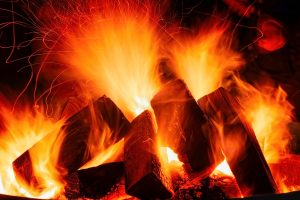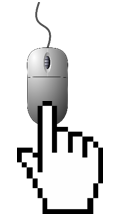4 Heat Energy Measurements
Click play on the following audio player to listen along as you read this section.
https://video.bccampus.ca/id/0_982zm8ys?width=608&height=50&playerId=23448552

Take a look at the picture of the fire to the left. If you were to describe that fire and you had the three words heat, temperature and energy to choose from, which would you say best describes the fire?
You might say that all three words could describe the fire and you would be right. As all three words can be used to describe a similar situation this could be confusing. As this chapter deals with heat energy you might have guessed that we are going look at this from the heat energy point of view. We’ll get to temperature in the next section but for now know that temperature is a measure of the intensity of the heat. We could describe the fire as very hot which would indicate a high intensity of heat.
At this point we should get a definition of energy. I’m going to refer to WIKIPEDIA here for the definition:
Energy: In physics, energy is the quantitative property that must be transferred to an object in order to perform work on, or to heat, the object.
Thanks Wikipedia!
There are many forms of energy. We are just going to focus on heat energy in this section.

If you would like to know more about the different forms of energy check out the following link: Types of Energy (Solar Schools)
Measuring Heat Energy
In the last two sections we started off by going through the metric units and then the imperial units. Well there are only two units for each that we are going to deal with so we’ll introduce them all at once and then work through examples within metric and within imperial and then work between them. The four units we are going to deal with are as follows:
| Metric | Imperial |
|---|---|
| kilowatts (kW) | British thermal unit (btu) |
| calories (cal) | joules (J) |
Let’s take a look at the relationship between each of the units.
| Unit | Equivalent |
|---|---|
| kilowatt | 3412 btu’s 860,421 cal |
| British thermal unit | 0.293 kW 1055 J |
| calorie | 4.186 J |
| joules | 0.239 cal |
Note that there are a couple of equivalent numbers missing such as the number of kilowatts in a joule. These are not included as they are either too small or way large to bother with. The numbers above are generally the ones we need to know.
Something else to note is that often instead of using calories and joules we use kilocalories and kilojoules. A kilocalorie (kcal) is 1000 calories and it takes 1 kilocalorie to raise the temperature of 1 kilogram of water 1°C. As we learned before there are 1000 grams in one kilogram. Following the logic it would then take 1 calorie to raise 1 gram of water 1°C.
[latex]\begin{array}{rcl} \text{1 kilocalorie (1000 calories)} & \longrightarrow & \text{raises 1 kilogram (1000 grams) of water 1°C} \\ \text{1 calorie}& \longrightarrow & \text{raises 1 gram of water 1°C} \end{array}[/latex]
This same logic follows for the joule. One kilojoule equals 1000 joules. If we relate it to increasing the temperature of water what we would see is that is takes 1 joule to raise 1 gram of water 0.24°C. Following the same logic as the calorie and kilocalorie it would take 1 kilojoule to raise 1 kilogram of water 0.24°C.
[latex]\begin{array}{rcl} \text{1 kilojoule (1000 joules)} & \longrightarrow & \text{raises 1 kilogram (1000 grams) of water 0.24°C} \\ \text{1 joule}& \longrightarrow & \text{raises 1 gram of water 0.24°C} \end{array}[/latex]
We can take this a bit further and talk about the heat energy in a British thermal unit. The heat energy in one BTU is enough to raise one pound of water 1 degree Fahrenheit. It’s generally considered to be the amount of heat energy in a match.
 Remember that you can derive any other number you need from the conversion numbers given. These are the only number that you have to memorize.
Remember that you can derive any other number you need from the conversion numbers given. These are the only number that you have to memorize.
Let’s go through a few example questions to see where we are at.
Example
How many joules (J) are there in 14 British thermal units (BTU)?
Step 1: Find the number that translates between joules and British thermal units. Keep in mind that we are going from BTU’s to joules.
In this case we know that 1 BTU = 1055 joules
Step 2: As usual build a ratio.
[latex]\Large \dfrac{\text {1 BTU}}{\text{14 BTU's}} = \dfrac{\text{1055 joules}}{\text{X joules}}[/latex]
Step 3: Cross multiply.
[latex]\Large\begin{array}{c} \dfrac{\text {1 BTU}}{\text{14 BTU's}} = \dfrac{\text{1055 joules}}{\text{X joules}} \\ 1 \times \text{X} = 14 \times 1055 \\ \text{X} = 14,470 \\ \text{Answer} = 14,470 \text{ joules}\end{array}[/latex]
Example
How many kilowatts (kW) are there in 1,495, 276 calories (cal)?
Step 1: Find the number that translates between kilowatts and calories.
In this case we know that 1 kilowatt is equal to 860,421 calories. Note that we are going from calories to kilowatts and we don’t have the number of kW in one calorie. What we do have is the number to go from kilowatts to calories. We know that 1 kilowatt = 860,421 calories.
Step 2: Build a ratio using the number we do have.
[latex]\Large \dfrac{\text {1 kW}}{\text{X kW}} = \dfrac{\text{860,421 cal}}{\text{1,495,276 cal}}[/latex]
What you’ll note here is that when you get to the stage where you cross multiply the equation doesn’t end up as nice and easy to work with as we’ve had so far. We don’t end up with the “1 x X.” What we have to do here is manipulate the equation to solve for X. This is a little out of the scope of what we have gone through so far but you’ll find a full explanation in the next chapter. Having said all that let’s go through the motions to solve the equation.
Step 3: Cross multiply
[latex]\Large\begin{array}{c}\dfrac{\text {1 kW}}{\text{X kW}} = \dfrac{\text{860,421 cal}}{\text{1,495,276 cal}} \\ 1 \times 1,495,276 = \text{X} \times 860,421 \\ \text{X} = \dfrac{1,495,276}{860,421}= 1.738 \\ \text{Answer} = 1.738 \text{ kW}\end{array}[/latex]
Now try a question for yourself
Practice Question
Try a practice question yourself and check the video answer to see how you did. Make sure to follow the steps outlined above and think about whether your answer should be bigger or smaller.
Question 1
Amir and Parviz are installing a boiler. The boiler is rated at 110 kW. Their gas fitting ticket allows them to install and fire appliances up to and including 400,000 BTU’s per hour. Are they allowed to fire this appliance?
https://video.bccampus.ca/id/0_gdungmei?width=608&height=402&playerId=23448552

